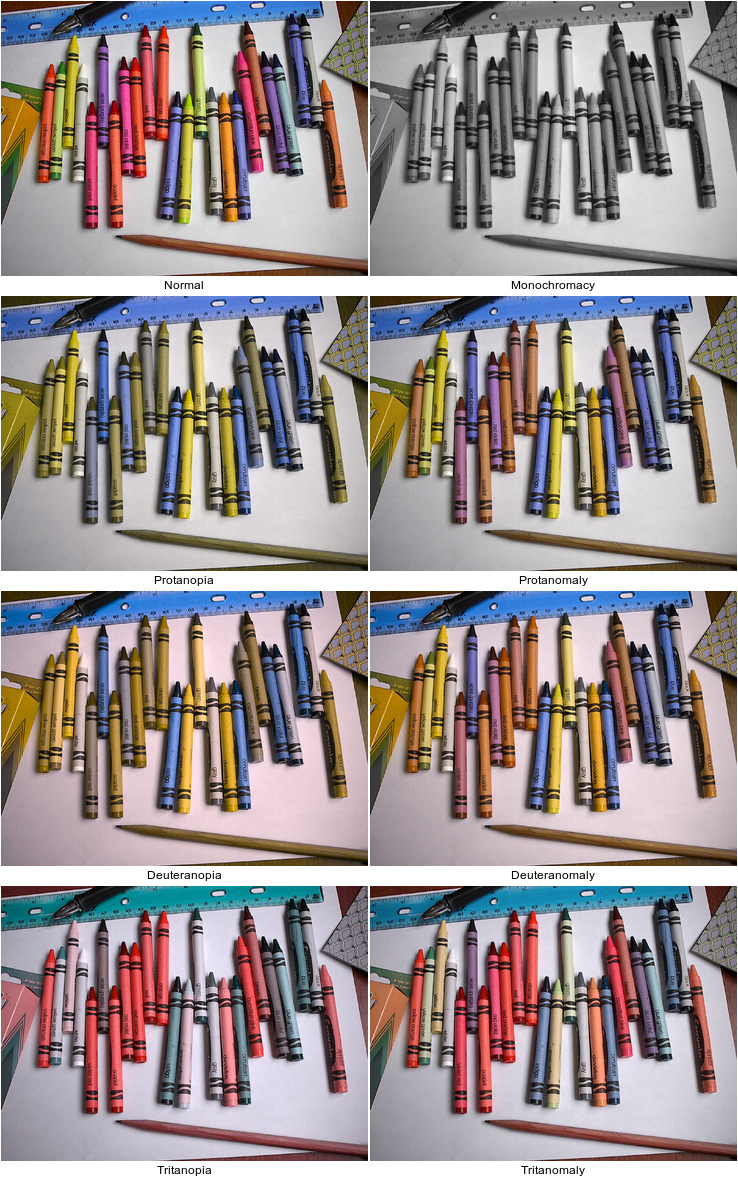Peacock is an application to convert static images (PNG, JPEG, etc.) from a full-color representation to something attempting to simulate what a colorblind person might see.
The objective of Peacock is to increase the accessibility of digital graphics and was originally created to verify that scientific visualizations were not ambiguous and/or misleading to colorblind viewers.
Coblis—Color Blindness Simulator and other such similar utilities are available online; however, sometimes online resources are inconvenient or inaccessible. Adobe Photoshop and other offline resources provide colorblindness simulation; however, all offline tools that could be located were cumbersome when processing multiple images for multiple forms of colorblindness. So, Peacock was written to provide an offline mechanism to simulate color blindness capable of being used with batch processing.
The types of colorblindness that can be simulated are (with prevalence information from here as cited on Wikipedia):
| Males Affected (%) | Females Affected (%) | |
|---|---|---|
| Dichromacy | 2.4 | 0.03 |
| Protanopia (red deficient: L cone absent) | 1.3 | 0.02 |
| Deuteranopia (green deficient: M cone absent) | 1.2 | 0.01 |
| Tritanopia (blue deficient: S cone absent) | 0.001 | 0.03 |
| Anomalous trichromacy | 6.3 | 0.37 |
| Protanomaly (red deficient: L cone defect) | 1.3 | 0.02 |
| Deuteranomaly (green deficient: M cone defect) | 5 | 0.35 |
| Tritanomaly (blue deficient: S cone defect) | 0.0001 | 0.001 |
| Other | ||
| Monochromacy (total color blindness) | rare | rare |
Despite being quite rare, simulating monochromacy was included because it can also be used to evaluate the suitability of an image to display well when printed without color.
The Python version (Peacock as peacock.py) came first as a proof of concept.
It was built using the conversion coefficients and process from
Coblis (with
permission; see License Information for more
information).
More details on the Python version are available in its README file.
However, the Python version is relatively slow. So, the C++ version was created
(Peacock++ as peacock). More details on the C++ version are available in its
README file. The Python version is kept because (a) some users
might find it more accessible and (b) the C++ version depends on ImageMagick
(Magick++), which some users may not have easy access to.
Converting the "Normal" image (original resolution 1600x1200) below to simulate the seven available forms of colorblindness takes approximately 4.5 minutes with Python and approximately 5 seconds with C++ (the C++ is roughly a factor of 50 faster than Python).
The shell script used to create the montage above is available here.
The conversion processes and coefficients herein are used with permission from Colblindor and were therein used with permission of Matthew Wickline and the Human-Computer Interaction Resource Network for non-commercial purposes. As such, this code may only be used for non-commercial purposes.
Original (Normal) image above obtained at the linked URL and is used under the Creative Commons Attribution-Share Alike 3.0 Unported license.
Peacock++ uses the args.hxx header-only C++ command line option parser for
command line argument processing from here.
This file is used under the MIT license (see top of args.hpp). More
information in Peacock++'s README.
